Wheelchair backs that support the spinal curves: Assessing postural and functional changes
- PMID: 32406808
- PMCID: PMC8986246
- DOI: 10.1080/10790268.2020.1760530
Wheelchair backs that support the spinal curves: Assessing postural and functional changes
Abstract
Objective: To compare outcomes using a wheelchair back designed to support the natural seated spinal curves versus an upholstered back that promotes posterior pelvic tilt and thoracolumbar kyphosis.Design: Cross-over intervention.Setting: Two free-standing spinal cord injury (SCI) model system hospitals.Participants: Fifty adults with motor complete SCI C6-T4, between the ages of 18-60 years who use a manual wheelchair for mobility were recruited from a convenience sample.Intervention: Each participant's wheelchair back support was removed and replaced by an upholstered back and a solid back in randomized order. Postural and functional outcomes, pain, and satisfaction were evaluated using each back.Outcome measures: Seated postural measurements included pelvic angle, spinal angle of kyphosis and linear measurement of spine. Functional outcomes included vertical forward reach, one stroke push, timed forward wheeling, ramp ascent and descent. Numerical pain rating and a satisfaction survey provided input pertaining to both backs.Results: The solid back demonstrated significance in seated postural measurements. Participants using the solid back trended to higher scores in functional outcome measures including vertical forward reach, one stroke push and timed ramp ascent. Participants reported increased satisfaction with comfort and stability with the solid back.Conclusions: This pilot study demonstrated that a wheelchair back, which supports the seated spinal curves improves upright posture, functional reach, and wheelchair propulsion skills. Further research is necessary to demonstrate statistical findings as well as to assess back height and lateral support.
Keywords: Functional outcomes manual wheelchair; Manual wheelchair; Wheelchair back supports.
Figures

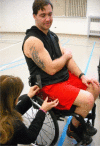
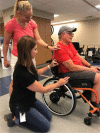
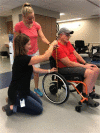
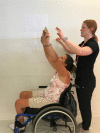
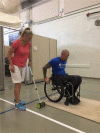





Similar articles
-
Wheelchair back-support options: functional outcomes for persons with recent spinal cord injury.Arch Phys Med Rehabil. 2004 Jul;85(7):1146-50. doi: 10.1016/j.apmr.2003.08.105. Arch Phys Med Rehabil. 2004. PMID: 15241766
-
Evaluating the Functionality and Usability of Two Novel Wheelchair Anti-Rollback Devices for Ramp Ascent in Manual Wheelchair Users With Spinal Cord Injury.PM R. 2017 May;9(5):483-493. doi: 10.1016/j.pmrj.2016.09.007. Epub 2016 Sep 21. PM R. 2017. PMID: 27664403
-
Relationships among cushion type, backrest height, seated posture, and reach of wheelchair users with spinal cord injury.J Spinal Cord Med. 2003 Fall;26(3):236-43. doi: 10.1080/10790268.2003.11753690. J Spinal Cord Med. 2003. PMID: 14997965 Clinical Trial.
-
Increased Seat Dump Angle in a Manual Wheelchair Is Associated With Changes in Thoracolumbar Lordosis and Scapular Kinematics During Propulsion.Arch Phys Med Rehabil. 2017 Oct;98(10):2021-2027.e2. doi: 10.1016/j.apmr.2017.02.014. Epub 2017 Mar 18. Arch Phys Med Rehabil. 2017. PMID: 28322758 Free PMC article.
-
Requirements for Universally Accessible Upper-Body Exercise Equipment: The Case of People with Spinal Cord Injuries in Korea.Occup Ther Int. 2023 Dec 22;2023:6652703. doi: 10.1155/2023/6652703. eCollection 2023. Occup Ther Int. 2023. PMID: 38161738 Free PMC article. Review.
Cited by
-
Development of an Evaluation System for Transfer Care Skills Using Embroidered Body Pressure and Proximity Sensor.IEEE J Transl Eng Health Med. 2023 Jul 10;11:460-468. doi: 10.1109/JTEHM.2023.3294062. eCollection 2023. IEEE J Transl Eng Health Med. 2023. PMID: 37817824 Free PMC article.
References
Publication types
MeSH terms
LinkOut - more resources
Full Text Sources
Medical
